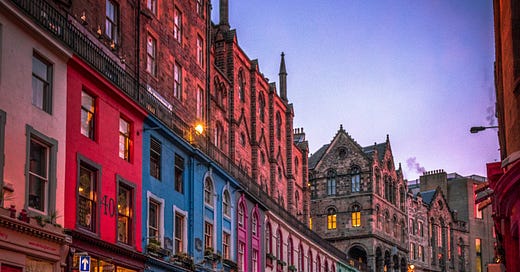Edinburgh has long been a city of two halves. Ever since the Georgians decided to escape from what was then the smelly, overcrowded city by building the elegant New Town there have been two very different experiences for visitors. The New Town with wide, elegant streets, expensive houses, the offices of grand financial institutions and plenty of shopping and eating experiences. The Old Town with (obviously) older brownstone buildings and narrower winding streets packed with tourists and tourist destinations, students and visitors. Princes Street, the gardens and Waverley Station acting as the effective border between the two.
When I was a boy growing up in Fife, just across the Forth from the big city, our occasional visits were based on the shopping hub of Princes Street, with occasional forays into other New Town shopping streets behind it, including Rose Street which housed the only shop for a time where we could get trousers long enough for a lanky teenager like me!
The only time we’d have ventured up the hill to the Old Town would have been to visit the castle or some other tourist attraction. As a shopping destination it just didn’t figure unless you wanted something tartan aimed at tourists.
A recent visit, though, provided a stark illustration of how much has changed. The Old Town is packed with fashionable places to eat and shop. Victoria Street (pictured) is a great example, with colourful restaurants of every shape and size, but I was also struck by the walk up to the old town through Cockburn Street, full of coffee shops, vintage clothing and other independent retail businesses.
Princes Street, by contrast, is looking a bit, well, faded.
With a number of sizeable empty units following various retail demises, the decidedly 70s architecture has a real whiff of ‘failing shopping centre’ about it. The recent opening of the St James Quarter at the end of the street has obviously not helped, drawing some of the bigger and more up-market brands that might once have regarded Princes Street as a must-have in their store estates.
But looking beyond the ups and downs of individual streets in the City, I can’t help wondering if the contrasting fortunes of the New and Old towns tell us something about the future of retailing too. Does smaller format, independent, strongly branded and physically attractive represent the future, whilst identikit, concrete, large format chain stores begin to look like they represent the past?
We should be under no illusions, of course, about the future for those shiny indie stores in the Old Town. Half of them will vanish, unable to turn their cool branding into actual profit. But with active management by landlords, councils and other stakeholders, there should be more ready to spring up to replace them. There is a virtuous circle to be created in the type of retail spaces that the Old Town creates where a strong lineup of stores drives footfall, making new entrants more likely to succeed.
That’s the opposite of the vicious circle that can sweep away more traditional shopping spaces like Princes St where empty stores become an infection and a street or centre starts to look tired, run-down and like a place you just don’t want to visit.
I suspect, in the end, the answer will be somewhere in between these two poles. There is a role for the big chain stores to fulfil in bringing people to the city (my mum is not the only person who makes a ritual visit from Fife to John Lewis on a regular basis). The city can also benefit greatly from having a flagship shopping street full of both chain and independent stores putting their best feet forward and parting those visitors with their cash.
But for all of us in retailing, and anyone interested in ensuring that town and city centres continue to evolve and thrive, there is much to reflect on from visits to the New and Old towns of Edinburgh. The right mix of big brands and experimental small ones. The right balance between hospitality and retailing. Indeed, the right mix between ‘Old’ and ‘New’ are all things it will be important to get right if we are to keep consumers happy and spending.






Hi Ian...I don’t know the retail scene in Edinburgh so well, but this certainly echoes what’s happening across other major cities. Take London as another example, where Oxford Street was ‘the shopping street’ but is now a tired old version of its former self, infected by the candy store plague, versus Covent Garden, a vibrant and thriving centre where smaller brands are opening flagship stores. If it wasn’t for Selfridges would anyone even, go to Oxford Street?
Linking this back to your previous post ‘Experience matters’, what is it that attracts so many customers to Selfridges? Surely, it’s the retail experience, as almost all the brands are accessible elsewhere. As well as having the iconic yellow bag, Selfridges creates a unique buzz and excitement that gives a compelling reason to visit the physical store. That compelling reason to visit can be great products or great service, but ideally both.